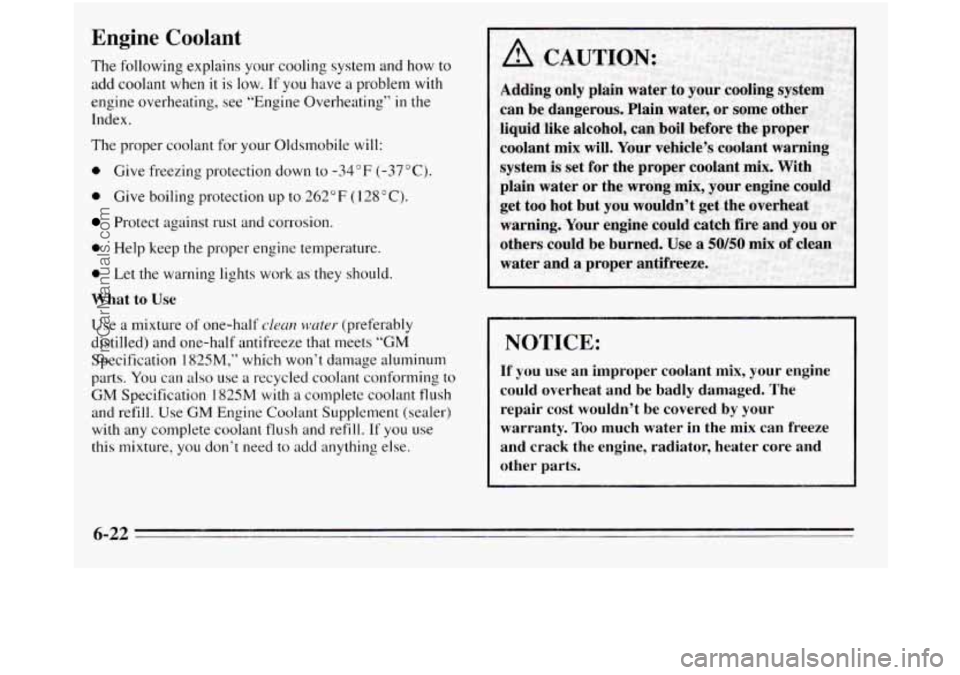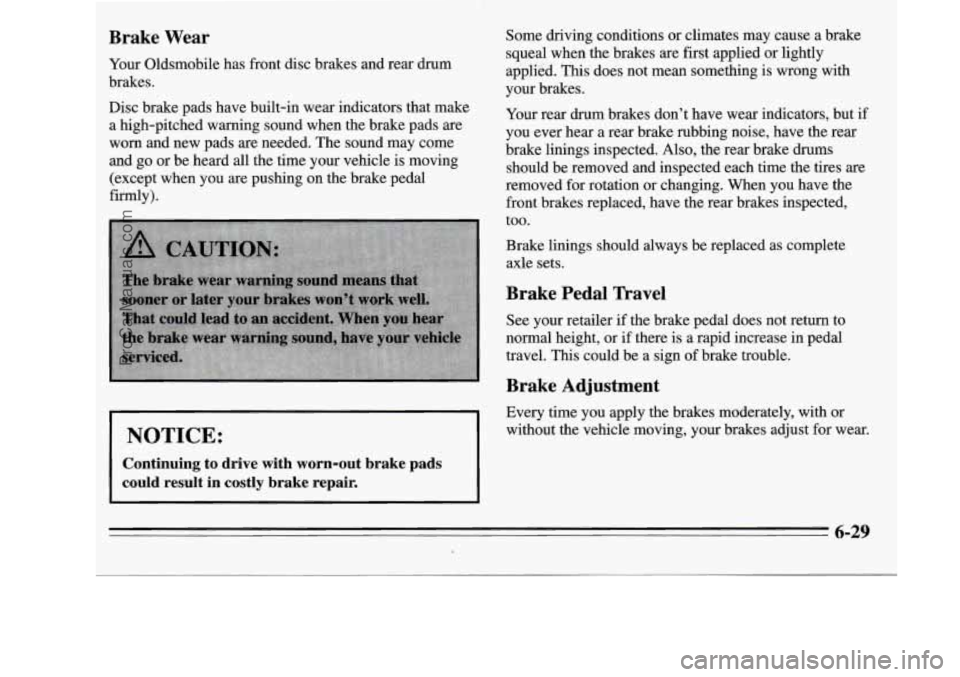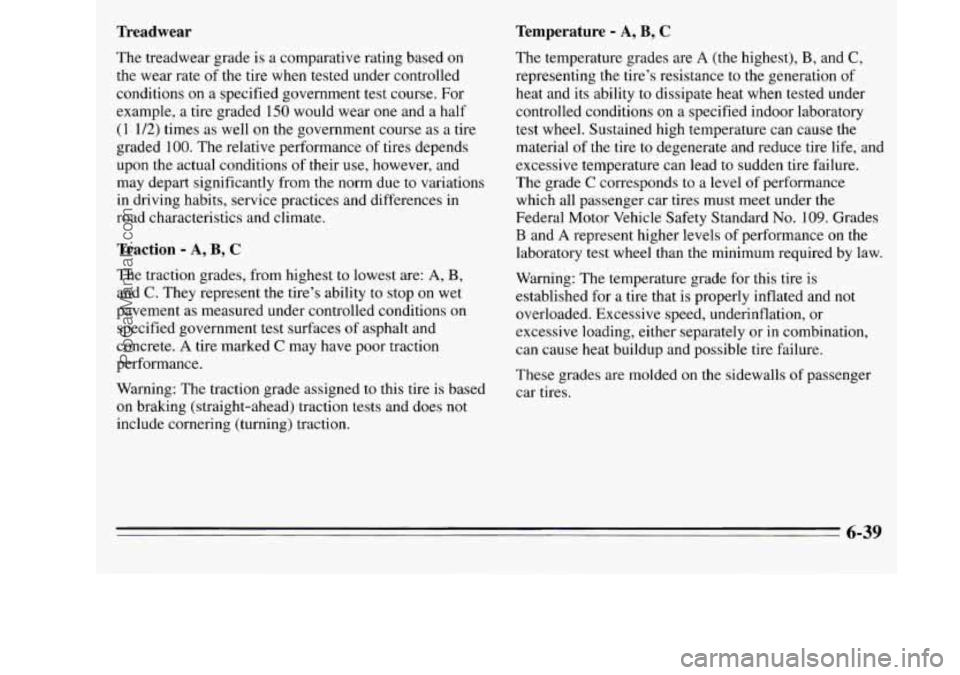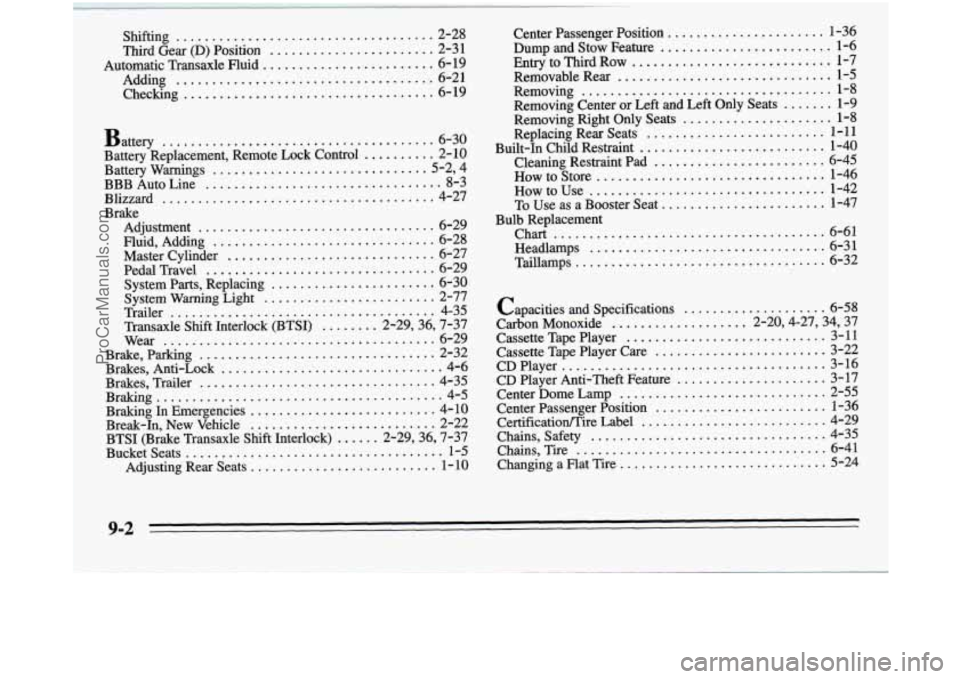1995 OLDSMOBILE SILHOUETTE warning
[x] Cancel search: warningPage 282 of 390

Engine Coolant
The following explains your cooling system and how to
add coolant when it is low.
If you have a problem with
engine overheating, see “Engine Overheating”
in the
Index.
The proper coolant for your Oldsmobile
will:
0 Give freezing protection down to -34°F (-37°C).
0 Give boiling protection up to 262 OF ( 128 ” C).
Protect against rust and corrosion.
0 Help keep the proper engine temperature.
0 Let the warning lights work as they should.
What to Use
Use a mixture of one-half clean water (preferably
distilled)
and one-half antifreeze that meets “GM
Specification
1825M,” which won’t damage aluminum
parts. You can also use a recycled coolant conforming to
GM Specification 1825M with a complete coolant flush
and refill. Use GM Engine Coolant Supplement (sealer)
with any complete coolant flush and refill.
If you use
this mixture,
you don’t need to add anything else.
NOTICE:
If you use an improper coolant mix, your engine
could overheat and be badly damaged.
The
repair cost wouldn’t be covered by your
warranty.
Too much water in the mix can freeze
and crack the engine, radiator, heater core and
other parts.
6-22
ProCarManuals.com
Page 288 of 390

should have your brake system fixed, since a leak means
that sooner or later your brakes won’t work well, or
won’t work at all.
So, it isn’t a good idea to “top off’
your brake fluid. Adding brake fluid won’t correct a
leak. If you add fluid when your linings are worn, then
you’ll have too much fluid when you get new brake
linings. You should add (or remove) brake fluid, as
necessary, only when work is done on the brake
hydraulic system.
When your brake fluid falls to a low level, your brake
warning light will come on. See “Brake System Warning
Light” in the Index.
~~
~~~ ~~~ ~
What to Add
The brake fluid reservoir is located to the left of the
windshield washer fluid reservoir, at the back of the
engine compartment.
When you
do need brake fluid, use only DOT-3 brake
fluid
-- such as Delco Supreme 11 @ (GM Part
No. 1052535). Use new brake fluid from a sealed
container only, and always clean the brake fluid
reservoir cap before removin,g it.
-
NOTICE:
0 Don’t let someone put in the wrong kind of
fluid. For example, just a few drops of
mineral-based oil, such
as engine oil, in
your brake system can damage brake
system parts
so badly that they’ll have to be
replaced.
0 Brake fluid can damage paint, so be careful
not to spill brake fluid on your vehicle.
If
you do, wash it off immediately. See
“Appearance Care” in the Index.
6-28
ProCarManuals.com
Page 289 of 390

Brake Wear
Your Oldsmobile has front disc brakes and rear drum
brakes.
Disc brake pads have built-in wear indicators that make
a high-pitched warning sound when the brake pads are
worn and new pads are needed. The sound may come
and go or be heard
all the time your vehicle is moving
(except when you are pushing on the brake pedal
firmly).
NOTICE:
Continuing to drive with worn-out brake pads
could result in costly brake repair.
Some driving conditions or climates may cause a brake
squeal when the brakes are first applied or lightly
applied.
This does not mean something is wrong with
your brakes.
Your rear drum brakes don’t have wear indicators, but
if
you ever hear a rear brake rubbing noise, have the rear
brake linings inspected. Also, the rear brake drums
should be removed and inspected each time the tires are
removed for rotation or changing. When you have the
front brakes replaced, have the rear brakes inspected,
too.
Brake linings should always be replaced as complete
axle sets.
Brake Pedal Travel
See your retailer if the brake pedal does not return to
normal height, or if there is a rapid increase in pedal
travel.
This could be a sign of brake trouble.
Brake Adjustment
Every time you apply the brakes moderately, with or
without the vehicle moving, your brakes adjust for wear.
6-29
ProCarManuals.com
Page 299 of 390

Treadwear Temperature - A, B, C
The temperature grades are A (the
highest), B, and C,
representing the tire’s resistance to the generation of
heat and its ability to dissipate heat when tested under
controlled conditions on a specified indoor laboratory
test wheel. Sustained high temperature can cause the
material of the tire to degenerate and reduce tire life, and
excessive temperature can lead to sudden tire failure.
The grade
C corresponds to a level of performance
which all passenger car tires must meet under the
Federal Motor Vehicle Safety Standard
No. 109. Grades
B and A represent higher levels of performance on the
laboratory test wheel than the minimum required by law.
The treadwear grade
is a comparative rating based on
the wear rate of the tire when tested under controlled
conditions on a specified government test course. For
example, a tire graded
150 would wear one and a half
(1 1/2) times as well on the government course as a tire
graded
100. The relative performance of tires depends
upon the actual conditions
of their use, however, and
may depart significantly from the norm due to variations
in driving habits, service practices and differences
in
road characteristics and climate.
Traction - A, B, C
The traction grades, from highest to lowest are: A, B,
and C. They represent the tire’s ability to stop on wet
pavement as measured under controlled conditions on
specified government test surfaces
of asphalt and
concrete.
A tire marked C may have poor traction
performance.
Warning: The traction grade assigned
to this tire is based
on braking (straight-ahead) traction tests and does not
include cornering (turning) traction. Warning:
The temperature grade for this tire is
established for a tire that
is properly inflated and not
overloaded. Excessive speed, underinflation, or
excessive loading, either separately or in combination,
can cause heat buildup and possible tire failure.
These grades are molded on the sidewalls
of passenger
car tires.
6-39
ProCarManuals.com
Page 302 of 390

Appearance Care
Remember, cleaning products can be hazardous. Some
are toxic. Others can burst into flame if
you strike a
match or get them on a
hot part of the vehicle. Some are
dangerous if you breathe their fumes in a closed space.
When you use anything from a container to clean your
Oldsmobile, be sure to follow the manufacturer’s
warnings and instructions. And always open your doors
or windows when you’re cleaning the inside.
Never use these to clean your vehicle:
0
0
0
0
0
0
0
0
0
Gasoline
Benzene
Naphtha
Carbon Tetrachloride
Acetone
Paint Thinner
Turpentine
Lacquer Thinner
Nail Polish Remover
They can all be hazardous
-- some more than
others
-- and they can all damage your vehicle, too. Don’t use any
of these unless this manual says you can.
In many uses, these will damage your vehicle:
Alcohol
Laundry Soap
0 Bleach
0 Reducing Agents
Cleaning the Inside of Your Oldsmobile
Use a vacuum cleaner often to get rid of dust and loose
dirt. Wipe vinyl or leather with a clean, damp cloth.
Your Oldsmobile retailer has two GM cleaners, a
solvent-type spot lifter and a foam-type powdered
cleaner. They will clean normal spots and stains very
well.
Do not use them on vinyl or leather.
Here are some cleaning tips:
0 Always read the instructions on the cleaner label.
0 Clean up stains as soon as you can -- before they set.
0 Use a clean cloth or sponge, and change to a clean area
often. A soft brush may be used if stains are stubborn.
0 Use solvent-type cleaners in a well-ventilated area
only. If you use them, don’t saturate the stained area.
If a ring forms after spot cleaning, clean the entire
area immediately or it will set.
6-42
ProCarManuals.com
Page 377 of 390

Section 9 Index
Accessory Power Outlet ......................... 2-57
Adding Automatic Transaxle Fluid
..................... 6-2 1
BrakeFluid ................................. 6-28
Electrical Equipment
............... 2.25.3.21. 6.51
Engine Coolant
.............................. 6-23
Engineoil
.................................. 6-12
Power Steering Fluid
......................... 6-26
SoundEquipment
............................ 3-21
Windshield Washer Fluid
................. 2.43. 6-26
AirBag
....................................... 1-26
How Does
it Restrain ......................... 1-29
How
it Works ............................... 1-28
Location
................................... 1-28
Readiness Light
........................ 1.27. 2.76
What Makes it Inflate
......................... 1-29
What Will You See After it Inflates
.............. 1-30
When Should
it Inflate ........................ 1-29
AirClealler
.................................... 6-17
Airconditioner
................................. 3-2
AirInflator
.................................... 2-63
Alignment and Balance. Tires
..................... 6-40
Aluminum Wheels. Cleaning
...................... 6-48
Servicing
................................... 1-31 Antenna.
Integrated Roof
......................... 3-23
Anti-Lock
..................................... 4-6
Anti-Lock Brake (ABS) Junction Block Fuse ......... 6-56
Anti-Lock Brake System Warning Light
......... 2.78. 4.7
Anti-Lock Brakes
............................... 4-6
Anti-Theft Feature. CD Player
.................... 3-17
Antifreeze
..................................... 6-22
Adding
.................................... 6-23
Checking
................................... 6-23
Appearance Care
............................... 6-42
Appearance Care and Materials
.................... 6-50
Ashtrays
................................... 2.65. 66
Audio Systems
.................................. 3-8
Auto Down Window Feature
...................... 2-39
Automatic Door Locks
............................ 2-5
Automatic Overdrive Position
..................... 2-30
Automatic Transaxle
............................ 2-28
Automatic Overdrive Position
.................. 2-30
First Gear (1) Position
........................ 2-32
Neutral
(N) Position .......................... 2-30
Park (P) Position
............................. 2-29
Reverse (R) Position
.......................... 2-29
Second Gear
(2) Position ...................... 2-31
Audio
System. Steering Wheel Touch Controls
....... 3-20
9-1
ProCarManuals.com
Page 378 of 390

Battery ...................................... 6-30
Battery Replacement. Remote Lock Control .......... 2-10
BBB Auto Line ................................. 8-3
Adjustment ................................. 6-29
Fluid, Adding ............................... 6-28
Master Cylinder ............................. 6-27
Pedal Travel ................................ 6-29
System Parts. Replacing ....................... 6-30
System Warning Light ........................ 2-77
BatteryWarnings ..............................5-2. 4
Blizzard ...................................... 4-27
Brake Trailer
..................................... 4-35
Transaxle Shift Interlock (BTSI) ........ 2-29.36. 7-37
Wear ...................................... 6-29
Brake. Parking ................................. 2-32
Brakes. Trailer .................................. 4-35
Brakes. Anti-Lock ............................... 4-6
Braking ........................................ 4-5
Braking In Emergencies .......................... 4-10
Break-In. New Vehicle .......................... 2-22
BTSI (Brake Transaxle Shift Interlock) ...... 2-29.36. 7-37
Bucketseats .................................... 1-5
Adjusting Rear Seats .......................... 1- 10
Capacities and Specifications ..................... 6-58
CarbonMonoxide ................... 2.20.4.27.34. 37
Cassette Tape Player ............................ 3-11
Cassette Tape Player Care ........................ 3-22
CD Player Anti-Theft Feature ..................... 3-17
Center Dome Lamp ............................. 2-55
Center Passenger Position ........................ 1-36
Certificatioflire Label .......................... 4-29
Chains, Safety ................................. 4-35
Changing a Flat Tire ............................. 5-24
CDPlayer ..................................... 3-16
Chains, Tire ................................... 6-41
9-2
ProCarManuals.com
Page 381 of 390

Engineoil .................................... 6-11
adding
..................... : .............. 6-12
Additives
................................... 6-16
Checking
................................... 6-11
What Kind to Use
............................ 6- 13
What to do with Used Oil
...................... 6-16
. Whentochange ............................. 6-16
Ethanol
(In Fuel) ................................ 6-3
Expectarit Mothers, Use
of Safety Belts ............. 1-31
Extender, Safety Belt
....................... : .... 1-57
Fabric: Cleaning
.......................... : .... 6-42
Filling Your Tank
................................ 6-4
Filter Aircleaner
................................. 6- 17
Engine
Oil .................................. 6-16
Finishcare
.................................... 6-47
Fihish Damage
............................ : .... 6-48
First
Gear (1) Position ............ ; .............. 2-32
Flashers, Hazard Warning
......................... 5-1
Flat Tire, Changing
............................. 5-24
FogLamps
.................................... 2-50
Foreign Countries, Fuel
........ : .................. 6-4
ForwardGears
................................. 2-30
FrontDoors
.................................... 2-3
Front Towing Ifbokups
.......................... 5- 11
Fuel
.......................... i............... 6-2
FillingYourTank
............................. 6-4
Gage
...................................... 2-86
In Foreign Countries ........................... 6-4 Fuse
Paiiel(3.lL V6 Engine)
............ ......... 6-53
Fuse Panel (3800 V6 Engine) ..................... 6-54
Fuses and Circuit Breakers
....................... 6-52
Gag&. Engine Coolant Temperature
............... 2-80
Garage
Door Opener Compartment.
Overhead Console
.............................. 2-5 1.
Gasolines for Cleaner Air .......................... 6-3
GAWR (Gross Axle Weight Rating)
................ 4-29
Gear Positions
................................. 2-28
Glass. Cleaning
................................ 6-46
GloveBox .................................... 2-21
GVWR (Gross Vehicle Weight Rating)
.............. 4-29
Halogen Bulbs
................................ 6-31
Hazqd Warning Flashers
.......................... 5-1
Head Restraints ................................. 1-4
Headlamp High-Low Beam Changer
............... 2-50
Headlamp. Wiring
.............................. 6-57
Headlamps
.................................... 2-49
Headlamps. Bulb Replacement
.................... 6-31
Hearing or Speech Impaired. Customer Assistance
...... 8-2
High Beam
Lamps. How to Change ................ 2-50
Highway Hypnosis
........................ ; ..... 4-22
HillandMountainRoads
......................... 4-23
Hitches. Trailer
i ................................ 4-34
HoodProp
..................................... 6-7
HoodRelease
................................... 6-6
9-5
ProCarManuals.com